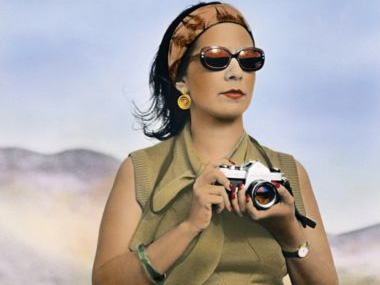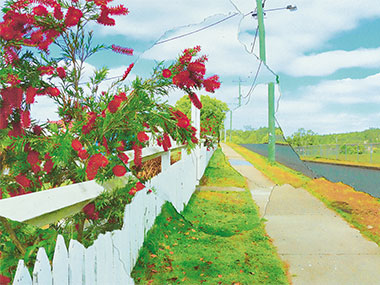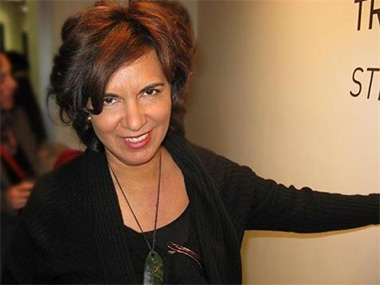TRACEY MOFFATT FOR VENICE

Tracey Moffatt's 'Self portrait' 1999. Courtesy of the artist and Roslyn Oxley9 Gallery, Sydney
Posted by Jeremy Eccles | 16.12.15
Photographer, film-maker and witty film montage-maker, Tracey Moffatt has been selected as the sole Australian representative for the 2017 Venice Biennale. She will be the first Indigenous-identifying artist to get a solo show there after Rover Thomas shared the Australian Pavilion with Trevor Nickolls in 1989 and the great Emily Kngwarreye was also made to share space with the different talents of Yvonne Koolmatrie and Judy Watson in 1997.
Koolmatrie, by the way was the recipient last week of the South Australian Premier’s Ruby Award for her lifetime contribution to the arts and culture of South Australia.
I wonder how long it will be before the powers that be notice what sort of impact a tribal artist like Warlimpirrgna Tjapaltjarri is having in the US and give him a solo in Venice? I ask, not to denigrate Moffatt's selection, but because I've been so thrilled by the positive, open-minded responses of critics in major US newspapers to both Warlimpirrgna's solo New York show and to Dennis Scholl's touring exhibition that includes his work, and by the more academic challenge of expat Aussie Terry Smith in a publication called 'Brooklyn Rail':
“Indigenous art comes from a temporality that has survived by insisting on its own deep difference, one that includes, fundamentally, its own logics of renewal. At the same time, this form of life incorporates modern times into it, as much of them as it needs, primarily in order to outlast them. In this way, it achieves its own contemporaneity, not as an abstract right, but on its own terms, and as a strategy for surviving the present. In doing these things, it offers the rest of us a glimpse of what inspires it to persist, and invites us to decolonize our ways of seeing. This art is showing us something about what it would be like to become true contemporaries.”
Tracey Moffatt, on the other hand, doesn't offer this “deep difference” but a very personal take on the world – one that often includes herself as hero standing up against discrimination of all sorts, or as victim of it. This is not always an Indigenous or gender stance – her work has universality; as this quote from her CV makes clear:
“Themes such as struggles between individuals, childhood cruelties in suburban life, the toughness of life on the ‘frontier’, the subversion of stereotypes and relations between black and white Australians are apparent in her works. Referencing the artist’s own life and experiences, Moffatt’s work deals with the human condition in all its complexities.”
Moffatt was born in Brisbane in 1960 and studied visual communications at the Queensland College of Art, from which she graduated in 1982. She had her first solo exhibition at the Australian Centre for Photography in Sydney in 1989, and has subsequently exhibited extensively in museums all over the world – mostly from a New York base. But who can forget the luminous 29 year old portraying herself as “the exotic flower in a Chinese cheongsam dress who has blossomed amidst white trash and wheat fields but dreams of another life. A road sign in the last photograph of the 'Something more' series points to 'Brisbane 300 miles'”!
That's a quote from curator Kathryn Weir in the QAG's 2014 tribute exhibition, 'Spirited' – in which QAGoMA Director Chris Saines hailed Moffatt as “arguably the most prominent Australian artist exhibiting national and internationally today”. And that iconic cheongsam self-portrait became so prominent that the artist denies its reproduction these days.
She first gained significant critical acclaim when her short film Night Cries: A Rural Tragedy – establishing her “highly constructed visual style and intertwining elements of melodrama and social commentary” - was selected for official competition at the 1990 Cannes Film Festival. Her feature film, beDevil, was also selected for Cannes in 1993. In 1997, she was invited to exhibit in the Aperto section of the Venice Biennale. A major exhibition of Moffatt’s work was later held at the Dia Center for the Arts in New York in 1997/98 which consolidated her international reputation.
Comprehensive survey exhibitions of Moffatt’s work have been held at the Museum of Contemporary Art, Sydney (2003-4), the Hasselblad Centre in Goteburg, Sweden (2004) and at the Art Gallery of South Australia (2011). In 2006, she had her first retrospective exhibition Tracey Moffatt: Between Dreams and Reality in Italy, at Spazio Oberdan, Milan. In 2007 a major monograph, The Moving Images of Tracey Moffatt, was published by Charta Publishers, Milan. A solo survey exhibition featuring all seven video montage works at the Museum of Modern Art, New York opened in May 2012.
Tracey Moffatt was the recipient of the 2007 Infinity Award for art by the International Center of Photography, New York. Infinity Awards are given for outstanding achievements in photography by honouring individuals with distinguished careers in the field and by identifying future luminaries. In 2016 the Art Gallery of NSW will present Laudanum and other works, which will provide an in-depth study of her use of the still and moving image.
Moffatt was selected by a five-member panel comprising: Naomi Milgrom AO, Australian Commissioner for the Venice Biennale 2017, Chair; Nicholas Baume, Director and Chief Curator, Public Art Fund, New York; Rebecca Coates, Acting Director, Shepparton Art Museum and independent curator; Lisa Havilah, Director, Carriageworks; and Chris Saines, Director, QAGoMA.
Milgrom – from the Melbourne Besen dynasty which established the TarraWarra Museum in the Yarra Valley - follows her partner John Kaldor and, more recently Simon Mordant in being the Venice Commissioner. It's a role that involves fund-raising as well as artist selection – with Mordant heavily involved in the funding of Australia's new Pavilion which opened this year.
Curator for Moffatt's show will be Melburnian Natalie King, who has strong Indigenous connections through co-curating shows with Djon Mundine: The TarraWarra Biennial: Whisper in My Mask, the 13th International Photo Festival at the Dong Gang Museum of Photography, Korea, and Shadowlife, a major exhibition of Aboriginal photo-media with Asialink that toured to Bangkok, Singapore, Taiwan and Bendigo. She also curated Destiny Deacon’s survey exhibition, Walk & don’t look blak at the Museum of Contemporary Art, Sydney.
Tracey Moffatt said she was shocked by Milgrom’s telephone call inviting her to represent Australia, but has wasted no time embracing the idea: “I’ve already started on my artworks for the Australian Pavilion. Thank you, this is a privilege for me.”
Share this:
»  del.icio.us
»
del.icio.us
»  Digg it
»
Digg it
»  reddit
»
reddit
»  Google
»
Google
»  StumbleUpon
»
StumbleUpon
»  Technorati
»
Technorati
»  Facebook
Facebook
Contact Details

'Picturesque Cherbourg no 1' (2013) - a picture-postcard image of the Queensland town where Moffatt's family was forced to relocate last century

A more recent portrait of the artist, headed for the 2017 Venice Biennale
Further Research
Artists: Emily Kngwarreye | Judy Watson | Rover Thomas | Tracey Moffatt | Trevor Nickolls | Warlimpirrgna Tjapaltjarri | Yvonne Koolmatrie
News Tags: Australia Council | Jeremy Eccles | Naomi Milgrom | Natalie King | Something More | Tracey Moffatt | Venice Biennale
News Categories: Blog | Europe | Event | Exhibition | Feature | Festival | Industry | News
Exhibition Archive
- 10.10.17 | TARNANTHI 2017
- 11.08.17 | Natsiaas 2017
- 20.07.17 | APY ART DOMINATES THE WYNNE
- 17.07.17 | Anangu Artist Wins $100,000 Prize
- 14.07.17 | The End of AAMU
- 11.07.17 | ART ACROSS THE COUNTRY
- 11.07.17 | TARNANTHI IN OCTOBER
- 05.07.17 | TJUNGUṈUTJA - from having come together
- 13.06.17 | Ghost-Nets Straddle the World
- 07.06.17 | Grayson Perry Going Indigenous?
- 05.06.17 | Barks Bigger than Ben Hur
- 27.05.17 | NGA QUINQUENNIAL 2017
- 21.05.17 | Blak Douglas Finds Home at the NGA
- 21.05.17 | BRIAN ROBINSON WINS HAZELHURST WOP
- 18.05.17 | PARRTJIMA 2.0
Advertising

